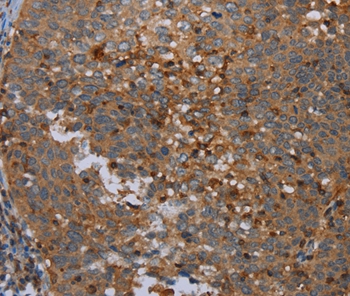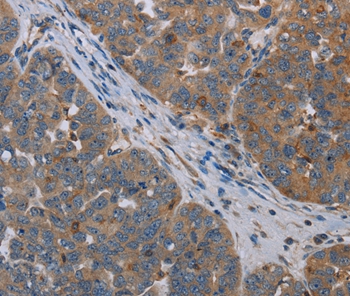

| WB | 咨询技术 | Human,Mouse,Rat |
| IF | 咨询技术 | Human,Mouse,Rat |
| IHC | 1/50-1/200 | Human,Mouse,Rat |
| ICC | 技术咨询 | Human,Mouse,Rat |
| FCM | 咨询技术 | Human,Mouse,Rat |
| Elisa | 咨询技术 | Human,Mouse,Rat |
| Aliases | FDP; MIAL1 |
| Entrez GeneID | 56914; |
| Host/Isotype | Rabbit IgG |
| Antibody Type | Primary antibody |
| Storage | Store at 4°C short term. Aliquot and store at -20°C long term. Avoid freeze/thaw cycles. |
| Species Reactivity | Human |
| Immunogen | Synthetic peptide corresponding to residues near the C terminal of human otoraplin |
| Formulation | Purified antibody in PBS with 0.05% sodium azide. |
+ +
以下是关于OTOR(Otoancorin)抗体的3篇参考文献,涵盖其功能、基因定位及疾病关联研究:
---
1. **"Otoancorin, an inner ear protein restricted to the interface between the apical surface of sensory epithelia and their overlying acellular gels, is defective in autosomal recessive deafness"**
- **作者**: Heller S, et al.
- **摘要**: 该研究首次克隆并鉴定了OTOR基因编码的Otoancorin蛋白,阐述其在内耳感觉上皮细胞顶表面与覆盖的无细胞凝胶层(如耳石膜)之间的界面表达。研究指出OTOR缺陷可能导致常染色体隐性遗传性耳聋,并通过抗体标记技术定位其在内耳中的特异性分布。
---
2. **"Mutation in the gene encoding lysosomal membrane protein 2 (LIMP2) reveals its role in hearing loss and otolith formation"**
- **作者**: Nal N, et al.
- **摘要**: 研究通过基因定位分析发现OTOR基因(亦称LIMP2)突变与听力损失及耳石发育异常相关。文中利用OTOR抗体进行免疫组化实验,揭示该蛋白在内耳毛细胞中的关键作用,并探讨其作为遗传性耳聋潜在生物标志物的可能性。
---
3. **"Expression and functional analysis of Otoancorin in the mouse inner ear"**
- **作者**: Yan D, Liu XZ
- **摘要**: 通过构建Otor敲除小鼠模型,结合OTOR抗体的免疫荧光和Western blot分析,证实Otoancorin在内耳毛细胞发育和维持耳蜗结构完整性中的必要性。研究进一步揭示了OTOR缺失导致机械信号转导障碍,从而引发渐进性听力损失。
---
**备注**:OTOR抗体相关研究多集中于其在内耳发育及遗传性耳聋中的作用,上述文献为代表性研究,实际引用时建议通过PubMed或Google Scholar核对最新进展。
OTOR antibodies target the OTOR protein, also known as fibroblast growth factor receptor 1 oncogene partner (FOP), encoded by the OTOR/FGFR1OP gene. This protein plays a regulatory role in cellular processes such as cilia formation, cytoskeletal organization, and cell migration. It interacts with fibroblast growth factor receptor 1 (FGFR1) and other proteins, influencing signaling pathways involved in development and tissue homeostasis. Dysregulation of OTOR has been implicated in diseases like cancer, where abnormal expression may promote tumorigenesis or metastasis, and in ciliopathies, disorders linked to defective cilia function.
OTOR antibodies are essential tools for studying the protein's localization, expression levels, and molecular interactions in research. They are used in techniques like Western blotting, immunohistochemistry (IHC), and immunofluorescence (IF) to investigate OTOR's role in both physiological and pathological contexts. For example, these antibodies help identify OTOR overexpression in certain cancers or mutations in genetic studies of ciliopathies. Additionally, they contribute to exploring therapeutic strategies targeting OTOR-associated pathways. Despite their utility, challenges remain in ensuring antibody specificity and validating their applicability across diverse experimental models. Overall, OTOR antibodies are critical for advancing understanding of cellular dynamics and disease mechanisms linked to this multifunctional protein.
×